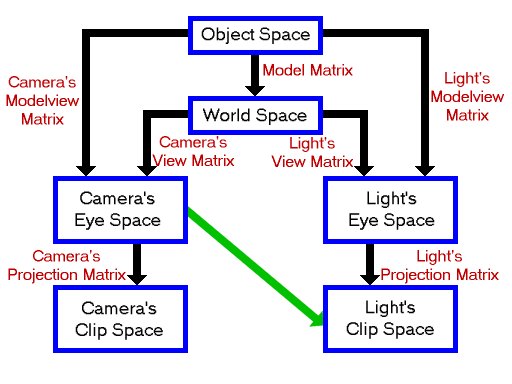Hi all,
I have read the fabien tutorial on basic shadow mapping here http://www.fabiensanglard.net/shadowmapping/index.php but my shadow mapping is wrong. Check the attached image.
I am calc. the lightMatrix using glm as follows.
lightOffsetMatrix=glm::translate(glm::mat4(1.0f), glm::vec3(0.5,0.5,0.5));
lightOffsetMatrix=glm::scale(lightOffsetMatrix, glm::vec3(0.5,0.5,0.5));
lightMV = glmLookAt(glm::vec3(light_position[0], light_position[1], light_position[2]),glm::vec3(0.0f), glm::vec3(0.0,1.0,0.0));
lightMatrix = (lightOffsetMatrix* (P*lightMV));
I define the glmLookAt function like this
glm::mat4 glmLookAt(glm::vec3 eye, glm::vec3 tgt, glm::vec3 up) {
glm::vec3 F = tgt - eye;
F = glm::normalize(F);
glm::vec3 newUp = glm::normalize(up);
glm::vec3 s = glm::cross(F,newUp);
up = glm::cross(s,F);
glm::mat4 matrix=glm::mat4(1.0f);
matrix[0]=glm::vec4(s.x, up.x,-F.x,0);
matrix[1]=glm::vec4(s.y, up.y,-F.y,0);
matrix[2]=glm::vec4(s.z, up.z,-F.z,0);
return glm::translate(matrix, -eye);
}
My vertex shader is this,
#version 330
in vec2 vUV;
in vec3 vVertex;
in vec3 vNormal;
smooth out vec2 vTexCoord;
smooth out vec4 vShadowCoord;
smooth out vec4 color;
uniform mat3 N;
uniform mat4 MV;
uniform mat4 MVP;
uniform vec4 lightPos;
uniform vec4 mat_ambient;
uniform vec4 mat_diffuse;
uniform vec4 mat_specular;
uniform float mat_shininess;
uniform vec4 light_ambient;
uniform vec4 light_diffuse;
uniform vec4 light_specular;
uniform mat4 lightMatrix;
void main()
{
vTexCoord = vUV;
vec3 Nr = normalize(N*vNormal); //transform the normal vector by the normal matrix (inverse transpose of the modelview matrix)
vec4 esPos = MV*vec4(vVertex,1);
vec3 ecPosition3 = (vec3 (esPos.xyz)) / esPos.w;
vec3 V = vec3 (0.0, 0.0, 1.0);
// Compute vector from surface to light position
vec3 L = lightPos.xyz - ecPosition3;
// Normalize the vector from surface to light position
L = normalize(L);
vec3 H = normalize( V + L);
vec4 A = mat_ambient*light_ambient;
float diffuse = max(dot(Nr,L),0.0);
float pf=0;
if (diffuse == 0.0)
{
pf = 0.0;
}
else
{
pf = max( pow(dot(Nr,H), mat_shininess), 0.);
}
vec4 S = light_specular*mat_specular* pf;
vec4 D = diffuse*mat_diffuse*light_diffuse;
color = A + D + S;
vShadowCoord = (lightMatrix*vec4(vVertex,1)) ;
gl_Position = MVP*vec4(vVertex,1);
}
and the fragment shader is this,
#version 330
smooth in vec2 vTexCoord;
smooth in vec4 color;
smooth in vec4 vShadowCoord;
out vec4 vFragColor;
uniform sampler2D textureMap;
uniform bool has_texture;
uniform sampler2DShadow shadowMap;
void main(void)
{
if(has_texture)
vFragColor = texture(textureMap, vTexCoord)*color;
else
vFragColor = color;
float shadow = texture (shadowMap, vShadowCoord.xyz);
vFragColor *= shadow;
}
Am i missing anything obvious.


